Menu

Recent thefts at high-end retailers are a good reminder that the holiday season can bring about more criminal activity. Make sure you are protecting your self-storage business from being vulnerable.
About a month ago, a Nordstrom department store in Walnut Creek, California was ransacked in what police are calling an “organized theft.” Anyone who may have seen the footage would agree that this was a well-planned, coordinated crime. Around 9 p.m. on a Saturday, the thieves entered the store, grabbed merchandise, and fled to their vehicles, which were parked haphazardly just outside the store, crowding the street. Two employees were assaulted, and another was doused with pepper-spray. Some arrests have been made, and police are still investigating.
What’s scary about this whole incident is the possibility that it might not be isolated, and how it clearly demonstrates what lengths people are willing to go to get what they want. While this may not happen at a self-storage facility, it’s a great reminder that all and any business is susceptible to theft.
The first thing to think about is, “How’s your security?” Many facilities with video and other security measures are experiencing break-ins. It’s not enough to add security and expect it to insulate your business from crime. You must also look for other creative ways to prevent it every day.
Components that can help include:
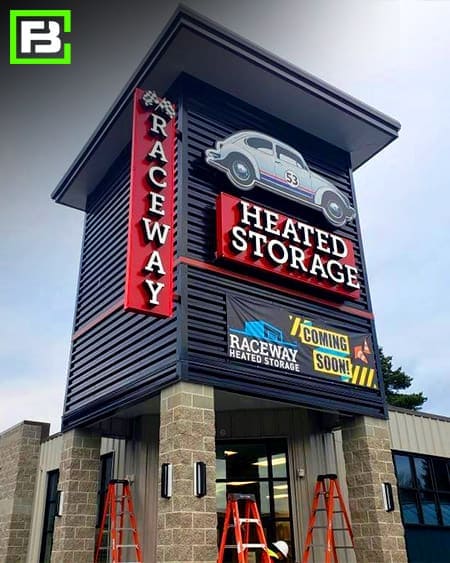 In addition to break-ins, there are a host of other problems that could wreak havoc on your business. Read this blog from a storage operator who dealt with vagrants hanging around and causing damage. Criminal activity increases during this time of year, so be on guard.
In addition to break-ins, there are a host of other problems that could wreak havoc on your business. Read this blog from a storage operator who dealt with vagrants hanging around and causing damage. Criminal activity increases during this time of year, so be on guard.
Besides having a solid security system, it is also important to walk around your property frequently and look for things that might seem out of place. For example, examine unit locks and keypads for tampering and encourage your tenants to report any unusual activity or events. Keep an eye on your security cameras as people move about your property. Make yourself present so everyone knows you’re keeping an eye on the facility. For clients of Forge, we conduct three daily walk-throughs to audit locks and doors, inspecting visual signs for any potential problems. We offer this service to our new and existing self-storage clients.
While it is key to keep your facility at a good occupancy level, that doesn’t mean you should ever let your guard down. When someone comes in to lease a unit, make sure you are following all protocols, checking identification and asking questions. Questionable people don’t like questions. They offer vague answers and might not look you in the eye. If their identification doesn’t check out, tell them you can’t accept it and don’t be afraid to say “no.” Self-Storage Talk members often share “dodge a bullet” moments when a prospect seems like trouble, and they refuse the rental.
In truth, it’s been a crazy, disastrous couple of years, and many people are desperate, especially at this time of year. Even those who might’ve never considered crimes before could be entertaining the thought. This person could already be a tenant! Or, someone who just drove by your site and thought it might be good for a burglary. Prospect to walk through your door may be casing your business. Don’t leave your facility vulnerable. Your self-storage site might not be Nordstrom, but it’s just as valuable to you.
 Whether you’re a seasoned veteran or new to the self-storage business, it is key that you learn how to identify and understand your target market using demographics as a tool. The correct use of this date is vital to your facility’s success. As with any real estate business or investment, location is of the utmost importance for a self-storage facility. It’s critical to understand your market, particularly if competitors are closing in.
Whether you’re a seasoned veteran or new to the self-storage business, it is key that you learn how to identify and understand your target market using demographics as a tool. The correct use of this date is vital to your facility’s success. As with any real estate business or investment, location is of the utmost importance for a self-storage facility. It’s critical to understand your market, particularly if competitors are closing in.
Demographics are the statistical data of a population within a defined geographic area. This usually includes population, age of the population, race, housing types, income levels, education levels and more. Knowing these details about your market will help you to make decisions about how to attract and service clients.
Sometimes you find a tract of land that looks good for self-storage. You may have driven around the area and become familiar with all the competitors, watched the traffic flow by the site, feel the price is right, and think local government officials will approve your development plan. When you look at the demographics reports for the area, you may find the region has a very low-density population and a very low-income level per person and household. However, you also may discover the majority of local residents rents their homes, and most of those live in multi-family units such as apartments or mobile-home parks. By doing some shopping, you find out the competitors are all full in their smaller unit sizes, and they’re all comparable in price. Second, you learn there’s sometimes a waiting list for certain unit sizes.
This information would tell me that in spite of the low density, a lot of this population appears to need storage, since the housing units are small, and they’re probably already using storage on a regular basis. The fact that unit prices are all on par indicates that price is important to this market, but there may be an opportunity to get slightly higher rents. The data also indicates that you probably shouldn’t build a “Cadillac” storage center when a mid-priced Chevrolet might work.
This information is, of course, just the beginning of what you would need to decide about whether to build, but it demonstrates how knowing market demographics can be extremely useful.
If you already operate a self-storage facility, and you’re noticing some drops in occupancy, using demographics reports can help you find out information such as:
 This presents a couple of interesting possibilities. For example, should you create any of your marketing materials in Spanish? What about putting some marketing materials together that show how freeing up room in the garage or carport makes for a less cluttered home and allows the homeowner to enjoy his space? You can even demonstrate how the average household should have some disposable income, since each home is well within the average income level for the area.
This presents a couple of interesting possibilities. For example, should you create any of your marketing materials in Spanish? What about putting some marketing materials together that show how freeing up room in the garage or carport makes for a less cluttered home and allows the homeowner to enjoy his space? You can even demonstrate how the average household should have some disposable income, since each home is well within the average income level for the area.
Using this data, you could also tell you that your market population is somewhat sophisticated and, thus, more prone to have a mobile device or computer. Now your method of advertising delivery can be varied and less costly.
These are just a couple of ways demographic information can be helpful. This information can also be used to determine unit pricing. If you find your area has a higher than average per-capita income level, it would be safe to assume your pricing could be a little higher. Conversely, if you’re having a hard time renting at your asking rates, you might want to look at the income levels in your market and make the appropriate adjustments.
Once you’ve identified your market using demographic data, it can be a useful tool in managing your marketing campaigns, determining which advertising sources to use, adjusting rental rates, predicting the unit types most likely to rent, etc. By knowing your market income levels, housing types, educational levels and more, will make your facility more productive and efficient. The use of demographic data is key to having a successful self-storage facility, whether it’s new to the market or well-established.
When you are ready to build or modify your self-storage facility, the team at Forge Building Company can help you achieve your goals. Give us a call to discuss your project.
To view our some of our recent project, see https://forgebuildings.com/projects/
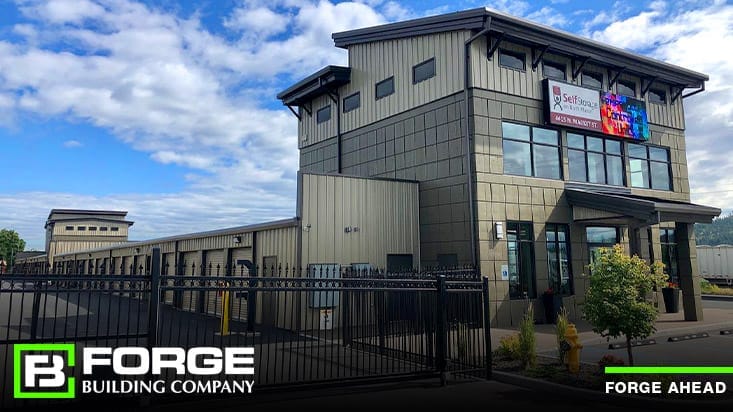
As this generation ages, so does the Millennial demand for self-storage. Self-storage demand continues to remain high in U.S. markets that have cultivated a following among millennials, according to a November 2018 self-storage report from real estate data provider Yardi Matrix. The report says self-storage development activity (planned and under construction) is percolating in several metro areas that draw millennials:
Other self-storage markets that attract millennials — including Austin, TX; Denver, CO; and Charlotte and Raleigh-Durham, NC — also are seeing robust development activity.
In many cases, millennials are renting self-storage units in tandem with apartments because the cost per square foot of storage is roughly 30 percent less than it is for an apartment. Even in less-hyped markets like Minneapolis, MN, millennials living in apartments are boosting self-storage demand.
But it’s not just apartment-dwelling millennials who are driving storage demand. As more millennials buy houses and amass wealth, they’re behaving more like their predecessors, and that includes renting storage units. As a percentage of households, millennials make up the biggest share of storage users in the U.S.
The Self Storage Association’s most recent demand study, released in December 2017, found that 14 percent of millennial households in the U.S. rented storage, with Generation X at 11 percent and baby boomers at 7 percent.
 Aside from shorter lengths of stay, some millennials are seeking out smaller storage spaces, presumably because millennials have less stuff than baby boomers. Rents are growing less for non-climate-controlled than for climate-controlled units, according to Yardi Matrix. (See our blog post on Generating More Revenue by Offering Climate Controlled Self-Storage)
Aside from shorter lengths of stay, some millennials are seeking out smaller storage spaces, presumably because millennials have less stuff than baby boomers. Rents are growing less for non-climate-controlled than for climate-controlled units, according to Yardi Matrix. (See our blog post on Generating More Revenue by Offering Climate Controlled Self-Storage)
Millennials are a “positive force” for self-storage expansion, Jeff Adler, vice president of Yardi Matrix, pointed out during an October 2018 webinar. Millennial employment is rising versus other age groups and millennials household formation is up too; the oldest millennials are now 40.
In a report published by Fort Worth, TX-based Karr Self-Storage, a team within Marcus & Millichap’s National Self-Storage Group emphasized that millennial demand for self storage is poised to lead the next generation of storage consumers, partly because of their desire for lifestyle flexibility and mobility.
“Many in the industry assumed that student debt, at-home living and slower career acceleration would prohibit the millennial cohort from becoming a reliable tenant base,” the Karr Self-Storage report says. “Although these macro trends may exist, many young people are obtaining full-time careers, purchasing homes, starting families and utilizing storage, just like previous generations.”
While Millennials took a little longer to become consumers, today they are buying houses, accumulating wealth, and are starting to behave like previous generations. As a percentage of households, they have the highest usage of storage and rank second when it comes to total users of storage. Millennials are the fastest growing client cohort. What remains to be seen is if they will be valuable clients. Today, many of them have a shorter length of stay than Gen X or Boomers.
Storage is a need-based product, generally triggered by some sort of a life transition (moving, remodeling, military deployment, going to college, divorce etc.). This applies to Millennials the same way it did to previous generations, and, on average, Millennials are more transient, so they are experiencing these transitions at a more frequent rate than previous generations. Also, with many of them living in smaller spaces in urban areas, some are using storage as a permanent solution for their lack of space.
Millennials are most focused on the location, the price and the ease of doing business with the storage provider.
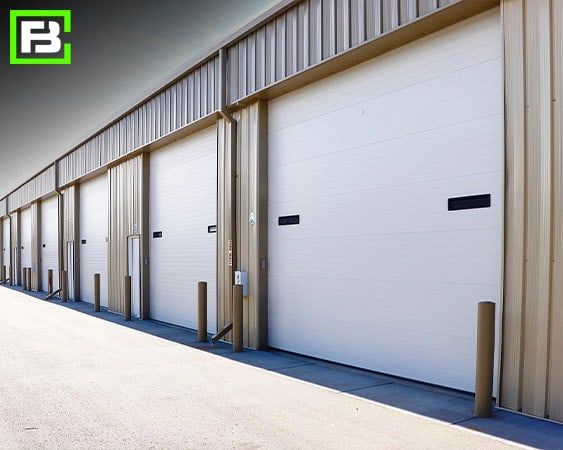 Technology has played a significant role in the storage industry, especially when it comes to how clients are acquired. Millennials spend significantly more time on devices than previous generations. Therefore, the focus should be on digital advertising, search engine optimization, advertisements and social media. Since storage is need-based, once people have the need, they generally rent quickly. Self-storage companies need to make sure they are visible online when they are making that decision.
Technology has played a significant role in the storage industry, especially when it comes to how clients are acquired. Millennials spend significantly more time on devices than previous generations. Therefore, the focus should be on digital advertising, search engine optimization, advertisements and social media. Since storage is need-based, once people have the need, they generally rent quickly. Self-storage companies need to make sure they are visible online when they are making that decision.
According to a Self-Storage Association study, 14% of all Millennials are already renting a self-storage unit. They also access the self-storage units quite often, with 20% visiting their unit several times per week, and are very interested in having access to their stuff 24/7. 61% of Millennials who rent self-storage say that anytime access to the unit is the most important feature for them.
Overall, Millennials are the most demanding generation when it comes to self-storage amenities. They really want it all: controlled humidity (51% of Millennial clients), pest control (57.7%), flexible contracts (52.8%), flexible means of payment (51.3%), discount rates for long-term contracts (50.9%), fire sprinklers (47.2%), tools for loading and unloading (46%), security guards (44.7%), and facility website (54.3%). While some believe millennials will use storage less than previous generations, data from Marcus & Millichap’s “2018 U.S. Self Storage Investment Forecast” suggests they will continue the demand trend as they still, although slightly later in life, are forming families and accumulating material possessions.

Very few places in the country are fortunate enough to avoid the frigid temperatures of winter every year. If you think it's cold outside, just imagine what it would be like in a storage unit. The freezing temperatures throughout the northern portion of the United States are cold enough to damage many belongings that are typically placed in storage. However, you can avoid damage caused by freezing temperatures by renting a climate controlled self storage unit, especially if you live in a region that experiences harsh winters.
Cold temperatures can be just as damaging to your belongings as to your body. Prolonged exposure to freezing temperatures can severely damage belongings commonly stored in a storage unit. Items to be especially cautious with include:
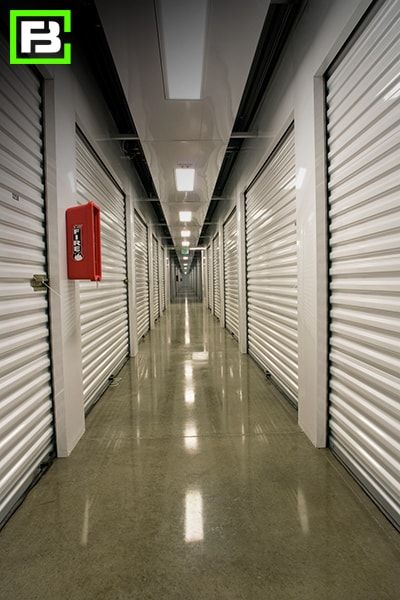 Electronics
ElectronicsFluctuating temperatures can create condensation inside electronics, causing irreparable damage. Likewise, anything with liquid already can crack due to expansion from freezing. This is especially true of battery cells, including those for cars, mowers, and other small engines, which can crack when frozen.
A temperature-controlled self-storage facility is both heated and cooled. Its purpose is to provide an environment suitable for preserving stored goods, so the temperature range will typically be higher or lower than what you would find in a home or office—usually heated to 55 degrees and cooled to 85.
While it’s commonly referred to as “climate-controlled” storage, the term “temperature-controlled” should be used unless the building also has a system to regulate humidity. Claiming to be climate-controlled while failing to address humidity might leave you open to legal trouble if the dampness damages a client's items. With today’s more efficient building insulation, it’s more important than ever to work with a reputable storage unit contractor to install a system that not only heats and cools but also monitors and removes humidity.
Let’s look at common uses, the benefits of temperature or climate control for self-storage facility owners and tenants, and some of the more critical design considerations.
The typical client who wants to rent climate-controlled storage has previously rented traditional storage with bad results and now wants to protect his or her belongings better.
Many people store unused items during the colder months of the year. Just as people store cold-weather items during the summer, you’ll often see people putting away summer belongings when the temperature drops. Storing seasonal items is an easy way to save space in your home. Here are a few seasonal belongings commonly stored during the winter.
Summer clothing – In a small living space, putting out-of-season clothing in a storage unit can make a big difference.
Another reason many people use storage during the winter is if they’re moving to a new home or apartment. While spring and summer are busier for real estate, people move year-round for various reasons. When moving, a storage unit can give you a place to store belongings between homes, making the entire process much more manageable.
Climate controlled self storage buildings offer several benefits for storage unit owners. First, you get increased land coverage. Compared to drive-up buildings, typically 30 to 40 feet wide, climate-controlled buildings can be up to 200 feet or more. This width reduces the amount of pavement necessary on the property and increases the amount of rentable space. The interior hallways are usually 5 feet wide and occupy only 15 to 20 percent of the space. This increased coverage can make it possible to develop on more expensive land in a better location than could be justified with traditional storage only.
Climate control can also serve as a market differentiator. Self-storage has penetrated just about every community in the country. Working with a quality self-storage contractor to incorporate climate control can set your site apart. So, while building and operating climate-controlled storage costs are higher, the increased rental rates are also significantly higher in most markets. These units usually rent for a 15 percent to 35 percent premium compared to standard units.
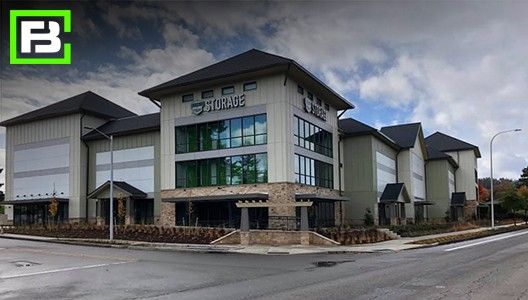 When it comes to the design of your temperature- or climate-controlled self-storage buildings, here are some common items to consider.
When it comes to the design of your temperature- or climate-controlled self-storage buildings, here are some common items to consider.
Costs. It’s common for commercial steel building developers to phase a project, but when planning a site with climate control, consider how the design will impact construction costs. The most cost-effective building is a large, wide structure.
Full vs. partial control. Some buildings are designed with both exterior-access ambient-temperature units and interior-access temperature-controlled units. While these projects allow for various unit types in a single structure, their popularity is declining. One reason is that the weather can create challenges when you build in a northern climate. Snow and ice will melt faster over the heated portions of a building, and if the runoff travels over a non-heated portion, ice dams may result.
Another reason is that stricter energy codes specify an insulated barrier between the foundations of climate-controlled and non-climate-controlled portions of a building. With the cost and complexity this adds to a project, it’s more cost-effective to design entirely climate-controlled buildings.
Unit access. Climate-controlled buildings are usually built with interior unit access via hallways, but more commercial steel building developers are building climate-controlled units with exterior access. These units should be equipped with insulated sectional doors (typically R-19 insulating value) rather than traditional roll-up doors. They should also be priced at a premium, as clients are willing to pay for the convenience of direct access.
Unit size. Interior-access buildings won’t contain units as large as those used for drive-up storage. The largest unit size in these buildings is typically 10-by-20.
Insulation. How much insulation do you need, and what kind will vary based on local building codes, weather conditions, and owner preferences? Projects can be built with spray-in foam, fiberglass bats, insulated panels or combinations. While building a project with a higher R-value will cost more, it pays benefits in two ways – your operating costs will be lower, contributing to a higher property value when it’s time to sell.
Roof pitch. You can choose from a variety of roof pitches for climate-controlled buildings. Roofs can be designed to allow room for the desired insulation thickness (R-value) directly under the panels. Or, on higher-pitched buildings, the insulation may be placed directly over the heated/cooled space ceiling, as you would find in a home, with insulation on the attic floor rather than under the rooftop.
Condenser location. Climate-control buildings commonly have recessed entries, which provide a staging area out of the weather and a place for the condenser unit. However, there are some options for putting the condenser unit outdoors. This may be the best option if there’s a place where it won't be vulnerable to client vehicles. Rooftop placement isn’t preferred due to the potential for creating leaks when penetrating the roof and possible damage from installers walking on the roof.
HVAC equipment. Your HVAC installer will guide you in choosing the equipment you need. However, HVAC equipment should be undersized for the space. It’ll run more often but consume less energy. In the summer, the result will be that the smaller HVAC system will circulate more air and do a better job removing humidity than a more robust system that runs for shorter intervals.
Most self-storage industry units across the U.S. are still the standard drive-up building; however, more sites are starting to include climate control. In some markets, many storage sites consist entirely of climate-controlled units. They can be an excellent addition to your storage development in the right market. Using insulation and central heating, a climate-controlled unit will protect your client's belongings in even the harshest winters.
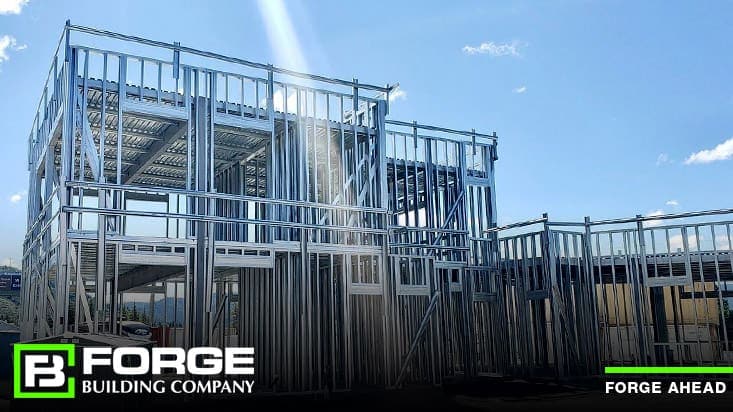
When it comes to building storage facilities or other commercial construction projects, custom steel buildings are an excellent choice. There are many factors that make commercial steel buildings a solid choice, including versatility, durability, energy efficiency, quicker builds, low maintenance, and cost effectiveness. Finding the right Commercial Steel Building Developers for your steel building project is crucial to your success. Erecting a metal building is a significant investment; your metal building contractor can make or break your project. So, keeping all of these factors in mind, it is a priority to find the right steel building contractor who can help design and develop the most cost-efficient commercial steel building that meets the requirements.
Commercial steel buildings are versatile and customizable to meet the project's needs. Steel buildings offer strength and the ability to be expanded as requirements change. The strength of the steel beams allows for a wide-open construction for large space requirements.
You can even achieve the appearance you are looking for with features like brick facades, wood veneers, vinyl siding or even stonework. The solid framework of a steel building allows for the inside to be remodeled easily as your needs change.
The construction of a steel building offers cost efficiency for the initial construction as well as the cost of ownership over time. For example, a steel building can be less expensive to insure as it offers resistance to fire damage. The strength and durability of a commercial steel building is built to last and should require less structural maintenance over the years of ownership.
Additional savings can come from lower maintenance requirements versus traditional wood or brick construction. The steel frame and metal panels are safe from the destructive effects of termites that can cause expensive damage.
Properly constructed commercial steel buildings offer excellent interior temperature protection. With proper insulation, ventilation, and HVAC service the interior climate can be preserved during extreme heat or cold weather. This is key for storage unit contractors. The building can also be designed in a way that encourages natural air flows that help with ventilation and comfort. This can be extremely important for use in commercial storage facilities.
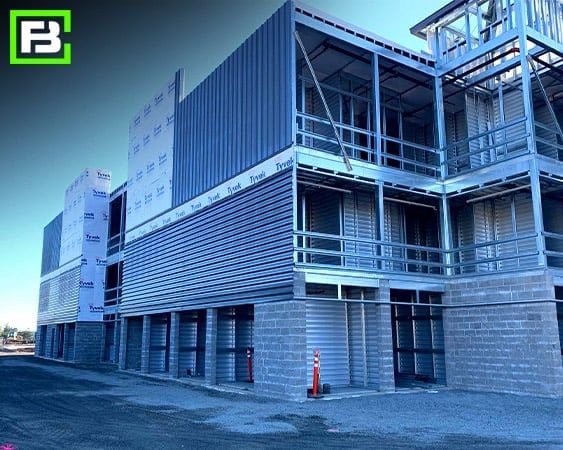 A commercial steel building can be built in much less time than a traditional brick or wood building. Commercial steel buildings are designed off site and made to fit together quickly and efficiently. This faster build time can make a big difference in carrying costs as well as construction costs. The shorter the construction time the sooner you can be utilizing the new building. This can mean faster revenue for your business or savings from being able to leave a less cost-effective location sooner.
A commercial steel building can be built in much less time than a traditional brick or wood building. Commercial steel buildings are designed off site and made to fit together quickly and efficiently. This faster build time can make a big difference in carrying costs as well as construction costs. The shorter the construction time the sooner you can be utilizing the new building. This can mean faster revenue for your business or savings from being able to leave a less cost-effective location sooner.
Steel metal buildings are now being used as warehouses, distribution centers, and industrial facilities. Commercially they are also used for office, government, and retail sectors. According to the Metal Building Manufacturer Association, shipments have grown to 1,094,064 tons in 2017 and this growth continues today. That’s why it is crucial to work with the most qualified commercial steel building contractor for your project.
One great example is where the team at Forge Building Company completed the Coppertop Storage Facility in Washington state. This 18,000 square foot pre-engineered steel building was added to an existing business park.
When selecting a steel building contractor, it is key to work with one that has created custom steel buildings of every shape and size. It is also most cost-effective and efficient when working with a company that:
The right steel building contractor should also be able to provide:
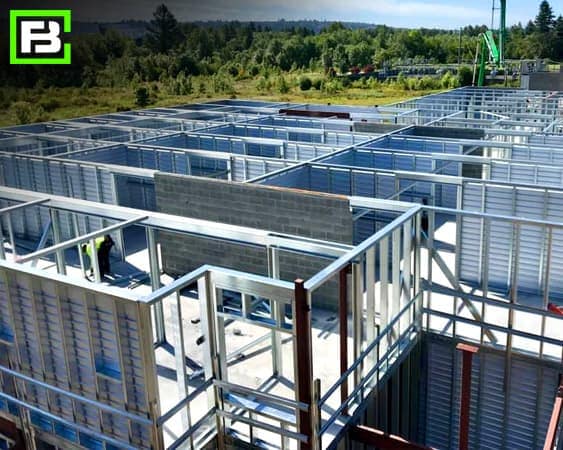 The most important factor when choosing between different metal building contractors is making the right choice. But the right choice will be different for different people. This is because everyone has different requirements and preferences. Therefore, the best way to make the right choice is to outline your requirements.
The most important factor when choosing between different metal building contractors is making the right choice. But the right choice will be different for different people. This is because everyone has different requirements and preferences. Therefore, the best way to make the right choice is to outline your requirements.
So, to make a proper decision, we recommend that you first decide which criteria are most important to you. It is helpful to divide your analysis into a few key areas. The features to consider include the following.
The first consideration should be what products and services the company offers. No metal structure is the same. So, if a company doesn’t offer the products and services necessary to help you achieve your specific project, it isn’t the right company for you.
This is why it is so important to have clear plans beforehand. If you have a clear idea of what you need to build and the services you require to build it, then you can easily see which company offers the best range of services.
Certain companies specialize in building different types of metal structures. Different companies also offer different construction services to help you build the structure. Know what you are looking for and find the company that offers it.
Of course, having the proper certifications to do the work offered is pretty much a bare minimum for any construction company. However, while not a concrete rule, you can expect a contractor with more certifications to have a better understanding of the industry. And while a more experienced company may cost a bit more, the extra experience is often worth it for the higher level of service.
Of course, price is a valid consideration in just about any decision you make. However, when shopping based on price, it’s best to think in terms of the quality that you are receiving for that price.
Price alone isn’t a very good metric because it doesn’t consider what you are getting for what you pay. You should first decide on which products and services you want and then shop based on price. See which company can give you the most value for the best price, and that’s the decision you want to make. Do your research on average costs to build self storage facilities in your market.
Client support is also a big one. This is especially important in this industry. Ongoing support is important when you have frequent questions about your construction process and steel building materials.
With metal building companies, look for one with a client support line that is easy to reach and covers many hours of the day. And with a construction service, good client support also includes a competent and efficient construction team.
Overall, try to find a company that is friendly, responsive, and very knowledgeable about their products and services. They should also be quick to solve any problems or issues that may arise.
It’s a great idea to research a company by looking at their website and their service offerings. To get a truly objective view of a company’s competence, you should be looking at client reviews.
These are just a few of the qualities that make custom steel buildings the right choice for business use cases. When you are ready to choose Commercial Steel Building Developers who can help you achieve your goals, the team at Forge Building Company will be ready to serve you.
To view our pre-engineered steel buildings, see our completed projects
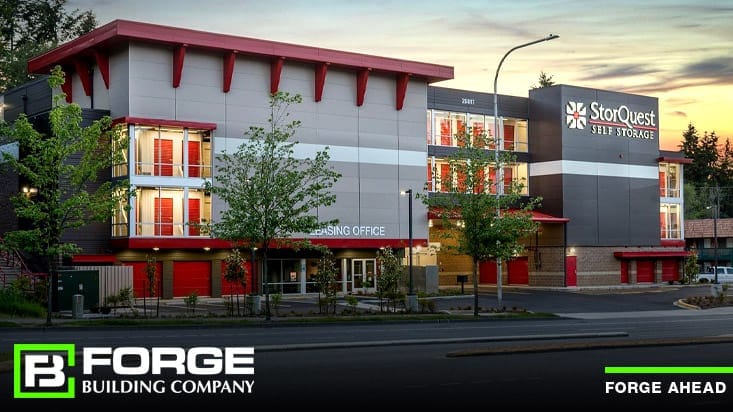
Storage facilities are found virtually everywhere in the U.S. In fact, self-storage units are among the highest-yielding real estate investments on the market. Once maintenance and security are in place, owners are free to collect numerous rent checks per square foot. Moreover, storage facilities remain buoyant during poor economic conditions.
The United States is the main player in the self-storage industry, where the industry is estimated to be worth $38 billion. There are approximately 50,000 storage unit facilities throughout the U.S offering more than 2.3 billion square feet of self-storage space.
About 18% of the industry is owned by the top five players, U-Haul and four (4) REITs (real estate investment trusts). This fact illustrates that there are numerous small, independent self-storage operations throughout the country building storage units. At any given time, about 10% of American households rent commercial storage units.
Life events such as moving, divorce and even death often trigger the need for temporary and long-term storage. It’s no wonder that more and more investors are looking for contractors to build commercial storage buildings.
Competition among self-storage units is greatest in metropolitan areas, where available, properly zoned land is at a premium. Many units are manufactured modular buildings that are easy and relatively quick to assemble. For this reason, building storage units has never been easier or more cost-effective.
 Vacant land can become an income producing asset for landowners looking to increase revenue. Land is valuable, and while land may be most valuable when a structure is built on it, this doesn't mean it can start producing income immediately. It all takes proper planning with the right steel building contractor that fully understands the entire process from land acquisition to the architectural process to final construction.
Vacant land can become an income producing asset for landowners looking to increase revenue. Land is valuable, and while land may be most valuable when a structure is built on it, this doesn't mean it can start producing income immediately. It all takes proper planning with the right steel building contractor that fully understands the entire process from land acquisition to the architectural process to final construction.
If you’re in the position of buying land for the purpose of converting it into a commercial storage development, you’ll need to understand a few things.
The minimum size of a self-storage facility is usually 40,000 square feet of rentable space, which typically requires two to three acres of land. The best sites are situated at major intersections that are easy to access and near a high, population density in a growing region.
Ideally, a self-storage facility would be free of nearby competitors and would also be close to a retail center. Of course, local zoning must permit building storage units in that specific location. So it is key to understand:
Every lot is different. You will likely have the option of using the equity in the land to pay the down payment on a construction loan. A lot goes into the development process, and lenders want to ensure they have as little risk as possible when lending money.
Putting the land up as equity when owned allows you to avoid paying cash for the down payment. Some lenders may require a cash investment, but this varies from lender to lender.
Once your loan is approved, you can begin developing the land into an income-producing storage facility. Storage units can generate a lot of revenue when you have the right structure built for that particular area.
In a previous blog titled “Building a Commercial Storage Building” we covered how to successfully build and develop a self-storage facility.
 Self-storage buildings offer a variety of individual storage rooms. In square feet, the most popular storage room sizes include: 5×10, 10×10, 10×20, 10×30, 15×20 and 20×20 (the later of which is approximately the same size as a two-car garage).
Self-storage buildings offer a variety of individual storage rooms. In square feet, the most popular storage room sizes include: 5×10, 10×10, 10×20, 10×30, 15×20 and 20×20 (the later of which is approximately the same size as a two-car garage).
The units typically have corrugated-metal walls, no windows and can be locked by the renter/tenant. Access to the facility may be secured by clerical staff, security guards, digital gate codes, alarms and security cameras.
Individual units might have a conventional lock or perhaps something more high-tech, such as a keypad, card reader, or biometric scanner. Higher-end units provide climate control, around the clock access, and power outlets within individual units.
For a sample of the types of single-story self-storage buildings that Forge offers, please check out: Single-Story Self-Storage Building Contractors.
Here are three points you should consider before hiring a storage building contractor:
The cost to build storage units starts with land costs and parcel sizes. A facility of 40,000 square feet requires a land parcel size of 2 to 3 acres. You need 3 to 4 acres for 60,000 square feet and 4 to 5 acres for 80,000 square feet, and so on.
Generally, about 40% of a storage facility’s client base demands climate-controlled units. This feature increases rental prices 25% to 60%, but costs only 10 cents per square foot! In other words, climate control has an incredibly high return on investment (ROI).
The coverage ratio of a site is the amount of land covered by the storage facility. For example, if you have 6,000 square feet of coverage on an 8,000 square foot lot, your coverage ratio is 75%. Naturally, the higher the ratio, the more revenue you can squeeze out of the storage facility. So bear that in mind before you start building storage units.
For single-story units, expect to pay $25-$40 per square foot, but multistory self-storage units typically cost $42-$70 per square foot. Additional cost factors like electricity, plumbing, and security systems can add $15-$45 per square foot. (source: Assets America)
In terms of constructing storage unit buildings, the cost can be relatively affordable. Depending on the region and building size, expect to pay $25,000-$100,000 for simple, steel buildings with 10-50 units. The cost to build storage units can be surprisingly within reach.
Developing land is a costly venture but finding the funds to develop the land with the best steel building contractor will also reap the highest return on investment.
Costs have changed since the posting of this blog. The hard and soft costs of construction will vary from project to project. Let’s break it down.
Keep in mind, that prices in materials, such as steel, may fluctuate and this directly impacts the cost per square foot. Also, you may be building in an area that is experiencing labor shortages causing the labor prices to increase as well.
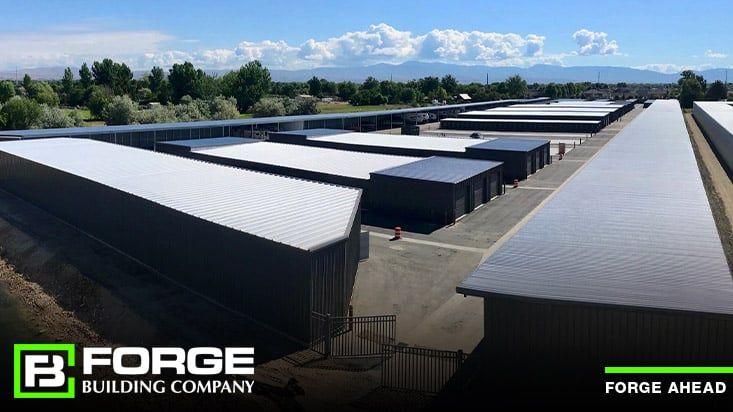
Through both good and bad economic times, the self-storage sector has proven to be a steady performer. That’s why so many investors want to get a piece of the action. To do so, you can either buy an existing self-storage facility or develop a new one. Successfully building a commercial storage building involves several factors, including choosing the right site, design, the correct unit mix, and layout. This may sound simple, right? Not so fast. Read more about these fundamentals and get advice on how to achieve optimal results.
If you go down the development path, one key question is: How much money will you need? There’s no simple answer to that question, as the cost can vary based on several factors, such as location and the number of self-storage units.
Ultimately, the goal of any self-storage development should be financial success, and the best way to accomplish that is to carefully plan the basics: site selection, unit mix, and layout. For many, the industry business model looks simple: buy land, build, and make money. It may once have been that simple, but today, it’s much more complex.
The commercial storage building market, like many similar markets are experiencing greater competition, higher land and building costs, and additional regulatory burdens. The industry, in general, is seeing the use of more climate-controlled and multi-story buildings, due in part to trends in consumer demand. As a result, self-storage facilities are becoming much more expensive to develop, with longer lease-to-stabilization times. Even so, they continue to be a solid investment choice.
Choosing the right site and creating a well-designed unit mix and layout is critical, especially for a first-time developer. These are the fundamentals of building a successful storage business, whether you’re building your first or fortieth facility.
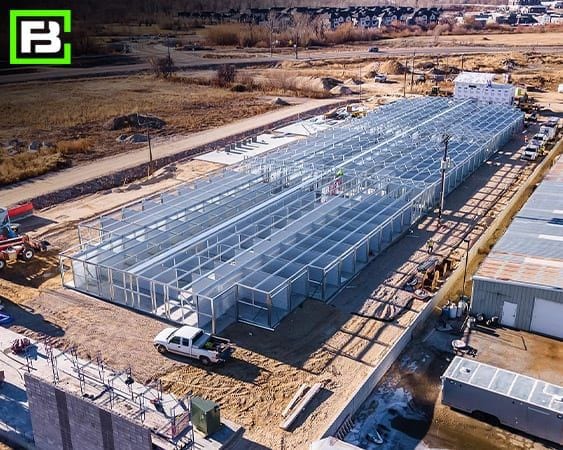
Site selection is the most critical factor in planning for the success of a commercial storage building. It is important to select a highly visible location, has good access, and is located on a major road. The site should be in a high-growth area or one that’s clearly in the path of progress for that region. In addition, it’s key to look for a good combination of demographics, with higher-than-average household income and population growth within a three-mile trade area. Finally, the location should have minimal existing or planned self-storage competition, particularly within the first few miles.
When you discover an area that’s underserved, chances are other self-storage building manufacturers and developers have noticed it as well. Check with the local building authority to see what’s being planned before starting a building project. You don’t have to let competitive forces sway your decision but it’s good to be aware of all existing and planned projects.
Once the site selection is determined, it is key that the property is large enough for your planned development and that it has access to the proper utilities, such as water, sewer, and electricity. It should also be properly zoned.
It is critical to understand that not all land is good for self-storage. A good site must have the attributes discussed previously. If it doesn’t, it is best to keep looking for one that does.
Typically, a single-story self-storage development might require three to five acres, depending on topography and shape. Whereas a multi-story self-storage site may only require two acres or so. The ideal site should give you a high level of confidence about all of the specifics of that particular location.
Generally, you can count on a self-storage facility costing $25 to $70 per square foot to build. That range can vary greatly. For instance, the cost of steel may go up or down at any given time, or the area where you’re building the facility may be experiencing a labor shortage. And, of course, you’ll certainly face higher costs in a major metro area than you would in a small community.
Self-storage unit mix is normally a product of population density and income levels. So it is key that you understand the market in which you are building the commercial storage-units. For example, areas of higher income will typically demand more security and climate-controlled features; apartment dwellers will want smaller units, say 5-by-10s; and suburban or commercial-oriented markets will call for larger spaces, such as 10-by-20s. Also, see our article on Determining the Right Unit Mix.
It’s important to note that your financial return per square foot (PSF) usually diminishes as the size of the unit increases. For example, if your market will support $70 for a 5-by-10, you’re achieving a rental rate of $16.80 PSF. It’s doubtful the 10-by-20 will support that same rate. This doesn’t mean you should build a higher proportion of smaller units, though. A store with 50,000 net rentable square feet might have more than 500 storage units or as few as 300, depending on the market. You must build the unit mix to the market, not to skew the PSF return.
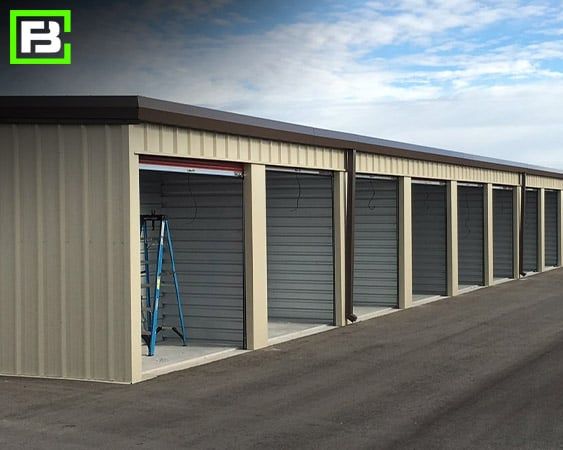
When you’re looking to develop a self-storage facility, you obviously must decide where to build it. Be prepared, finding a great site for storage can be tricky. You’ll need to find a site for the right price, with the right zoning, and the right demographics to support your business.
To discuss site layout, it’s key to understand building a single-story versus a multi-story storage facility. The layout process typically begins with the involvement of a professional civil engineer with experience in self-storage design, which can be invaluable. The goal is to maximize the net rentable square footage. You’ll typically be hunting for 2.5 to 5 acres to accommodate the facility. Land costs typically make up about 25% to 30% of the entire development budget and you will also need a site that will accommodate a minimum of 50,000 square feet, constructed all at once or in phases.
A single-story facility usually costs $25 to $40 per square foot. Construction of a multi-story facility typically costs more — $42 to $70 per square foot. These figures don’t include land or site improvement costs.
Of course, this isn’t a consideration if you already own property suited for a storage facility, although you still may need to go through the costly, time-consuming process of rezoning the land.
The layout is primarily a product of the shape and topography of the land parcel, but many other factors come into play, including:
At Forge, we normally factor in all the setbacks, easements, and storm-water restrictions first. From there, our drafters will then sketch the layout. Next, we try to determine how much climate-controlled versus non-climate-controlled storage can fit on the site. Then we look at accessibility to each of the buildings and individual units, ensuring it will be easy for clients to access their storage space. If it isn’t reasonably simple for tenants to drive in, get to their unit, and store their items, they’ll go elsewhere.
The key takeaway here is that it is critical to find the right site, then design the unit mix and layout based on that particular market. Doing the research and spending time with professional engineers and planners will help you succeed in your self-storage development. Remember, it’s a process that will involve a considerable amount of time and money, but the end reward will be worth it. At Forge, we can simplify the process by giving you a one-stop shop for all of your commercial storage building needs. Then once your new storage business is off to a solid start, you’ll be ready to focus on your next self-storage development project!
Related article: Before Construction Begins: Fundamentals of Building Self-Storage
Costs have changed since this blog was posted. The hard and soft costs of construction will vary from project to project. Let’s break it down.
Keep in mind, that prices in materials, such as steel, may fluctuate and this directly impacts the cost per square foot. Also, you may be building in an area that is experiencing labor shortages causing the labor prices to increase as well.
As builders Forge Building Company is used to risk – from labor shortages to escalating steel and construction pricing. Since 2007, self-storage developers have relied on Forge to create custom steel self-storage buildings of every shape and size. From initial concept through completed construction, the Forge team of highly certified professionals are experts at guiding clients through every step of designing and building a self-storage project. This includes site plan assistance, custom engineering, and installation.
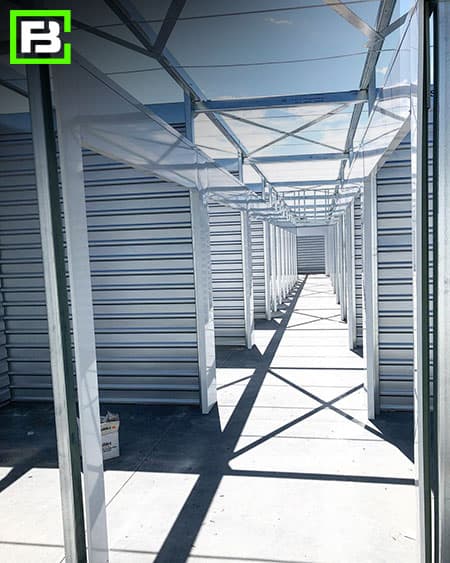 Over the last year, the company (and the industry as a whole) experienced varying degrees of impact because of the COVID-19 pandemic. Direct impacts ranged from a slowdown of available goods and labor through to suspensions and, in some instances, terminations of entire storage projects. Construction activities remained in flux in some states and cities depending upon whether construction was classified an essential business.
Over the last year, the company (and the industry as a whole) experienced varying degrees of impact because of the COVID-19 pandemic. Direct impacts ranged from a slowdown of available goods and labor through to suspensions and, in some instances, terminations of entire storage projects. Construction activities remained in flux in some states and cities depending upon whether construction was classified an essential business.
As a result, Forge took the opportunity to address both short-term and long-term business challenges, as well as formulating project-by-project solutions in the face of a new global and national environment. As a result, the company was able to forge ahead, building 45 of new self-storage steel buildings in 13 states, including Idaho, Washington, Oregon, California, Nevada, Arizona, New Mexico, Hawaii, Montana, Wyoming, Colorado, Michigan and Illinois through July of 2021.
The new realities touch almost every aspect of the construction process. Specifically, such issues as contract, scheduling, project suspension, projects being terminated and reinstatement; Occupational Safety and Health Administration (OSHA) and workplace safety compliance; workforce management; material, subcontractor and supply chain delays and impacts; risk management and insurance; claims avoidance or, alternatively, claims management; and the disputes process.

While there have only been a few reports of COVID directly impacting the U.S. construction workforce, Forge continues to be concerned with employee overall well-being. The good news is that the risk of transmission of this disease for those employed outside the healthcare sector is low, according to OSHA. Besides physical wellness, Forge is considering mental health, too, because many employers report anxiety among workers as one of the top issues brought on by the pandemic. In an informal Construction survey, 70% of respondents noted “employee anxiety” as their top concern, above material shortages and the prospect of government shutdowns.
In construction, everything comes down to time and money. Forge continues to be the leading nationwide self storage steel building contractor with an emphasis on self-storage developments. The Company has a 200+ field erect team that builds all projects for its clients, where other companies do not have their own teams and sub out the actual building proprietary. This provides consistent, innovative solutions for our clients. At Forge, the company listens to what its clients need to provide the most up-to-date, consistent solution using its proprietary methods.
Forge Building Company treats its clients, partners, and employees like family.
Meet the Forge Building Company team at the upcoming Self Storage Association Conference & Trade Show at the MGM in Las Vegas:
When: September 7-10, 2021
Where: Booth 135
The Self Storage Association is hosting its 2021 Fall Conference in person with an incredible lineup of industry expertise, executive participation and compelling talent. There’s a huge surge of deals and transactions happening in the self-storage industry, and Forge is no exception.
Forge has more than 45 development projects in the pipeline for the remainder of 2021, leading into 2022 nationwide. Still, there’s always room for more clients, and we’d welcome the opportunity to meet with you to make your company a part of the Forge family.
Unlike its competitors, Forge Building listens to clients' needs to provide the most up-to-date, consistent solution using its proprietary methods. The company’s experience, knowledge, and reputation in the industry provide its clients with stability. The treatment of its clients like family enables Forge to work closely with the client as a problem solver, providing the most innovative solutions for their building project.
Founded in 2007 and headquartered in Boise, Idaho, Forge Building Company was created after its founders, Hamish and Hayden, spent decades working in the steel-structure industry. Using their expertise in storage and focusing on the three pillars of buildings—designing, constructing, and erecting—led the company to a more diverse portfolio and stronger relations across the U.S.
Today, the company offers steel buildings for self-storage, RV and boat storage, car washes, airplane hangars, large warehouses, fish hatcheries, and craft breweries/restaurants. It also offers pre-engineered metal buildings for industrial and commercial applications.
With a strong portfolio of partners and clients, the Forge team has completed over 500+ jobs. It built over 50 million square feet, has over 250 workers, and remains privately owned. This solid team with complementary skills was founded on a rugby field in New Zealand over two decades ago and is now working to be the best in the industry.
For more information, please visit https://forgebuildings.com/ or to schedule an appointment, contact our Sales team at:
PH: 208-629-2952
Email: sales@forgebuildings.com